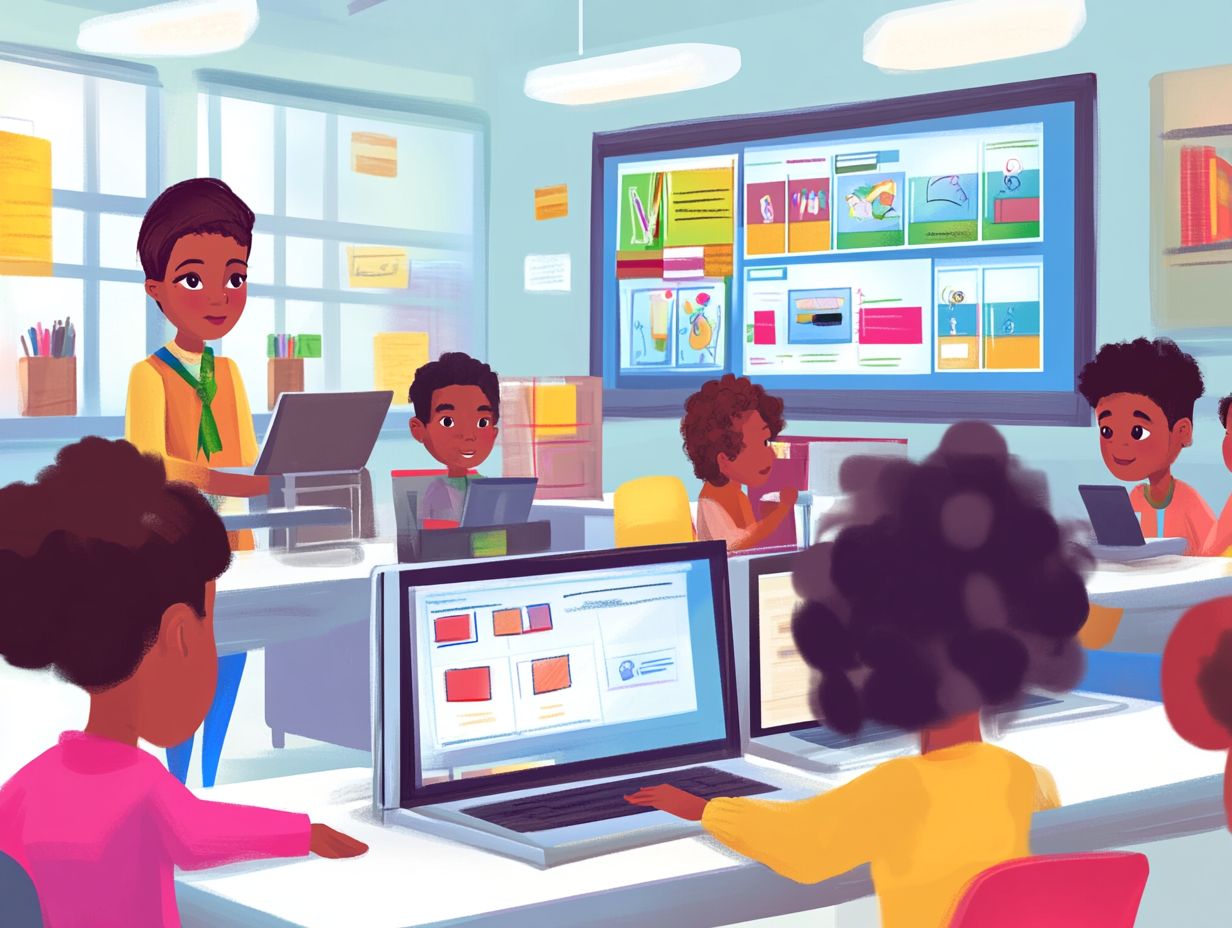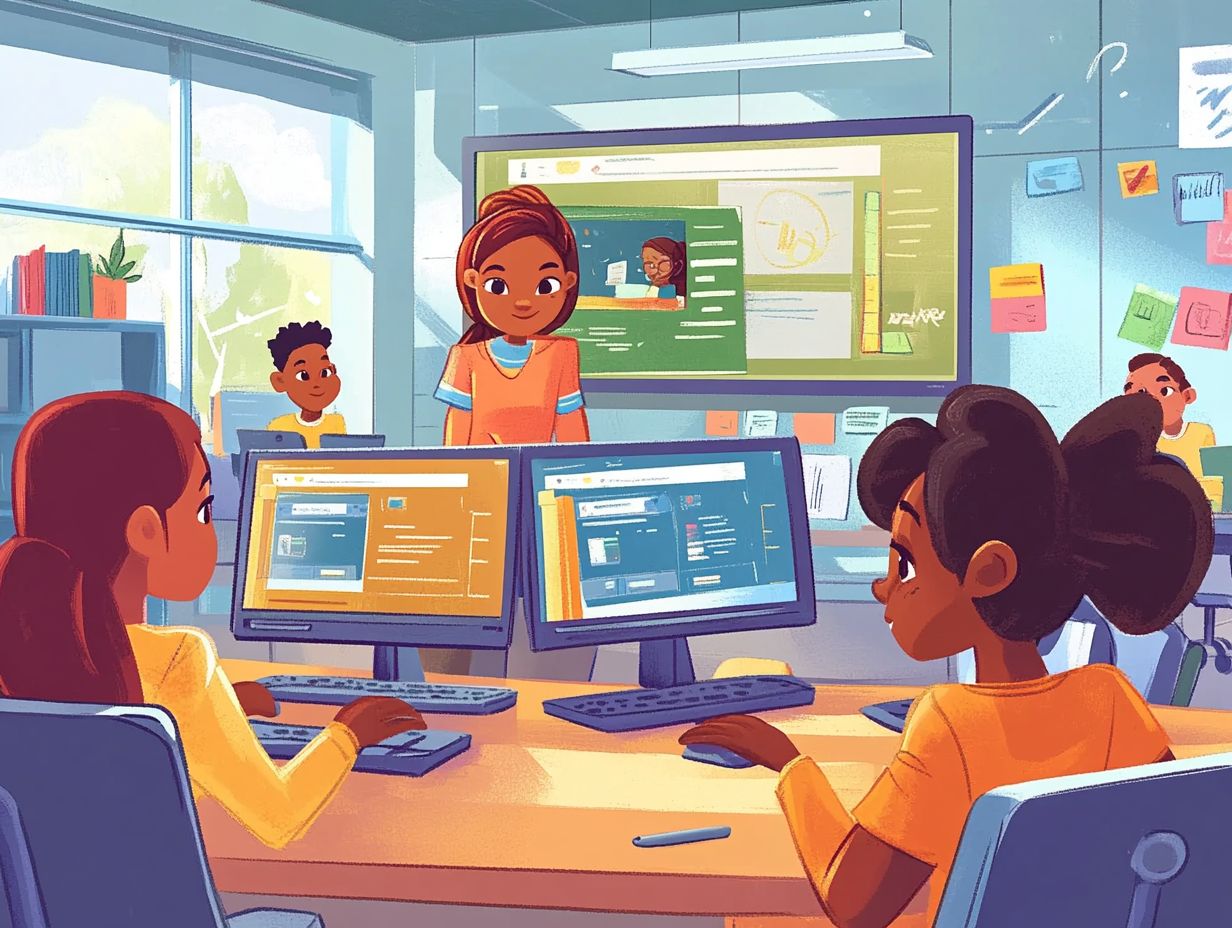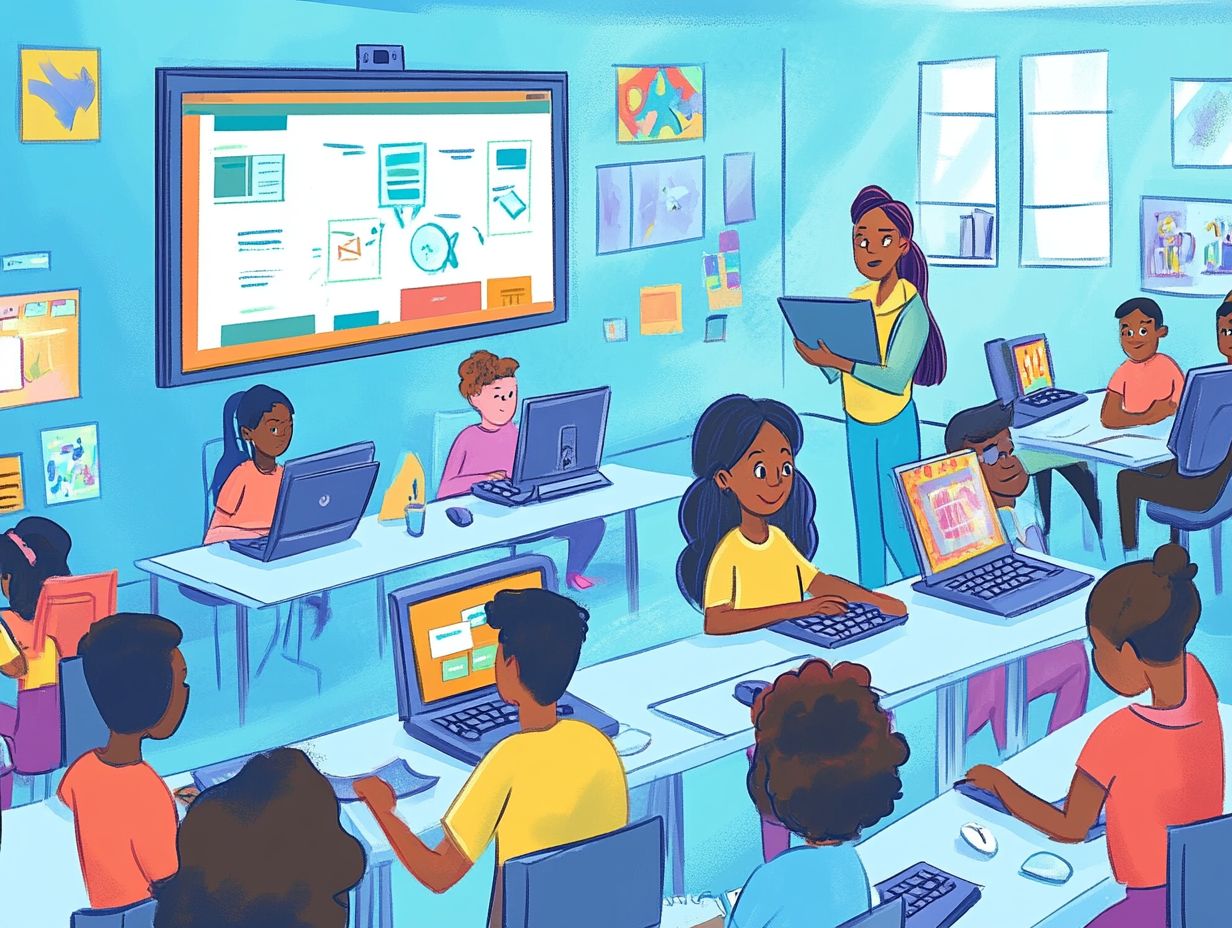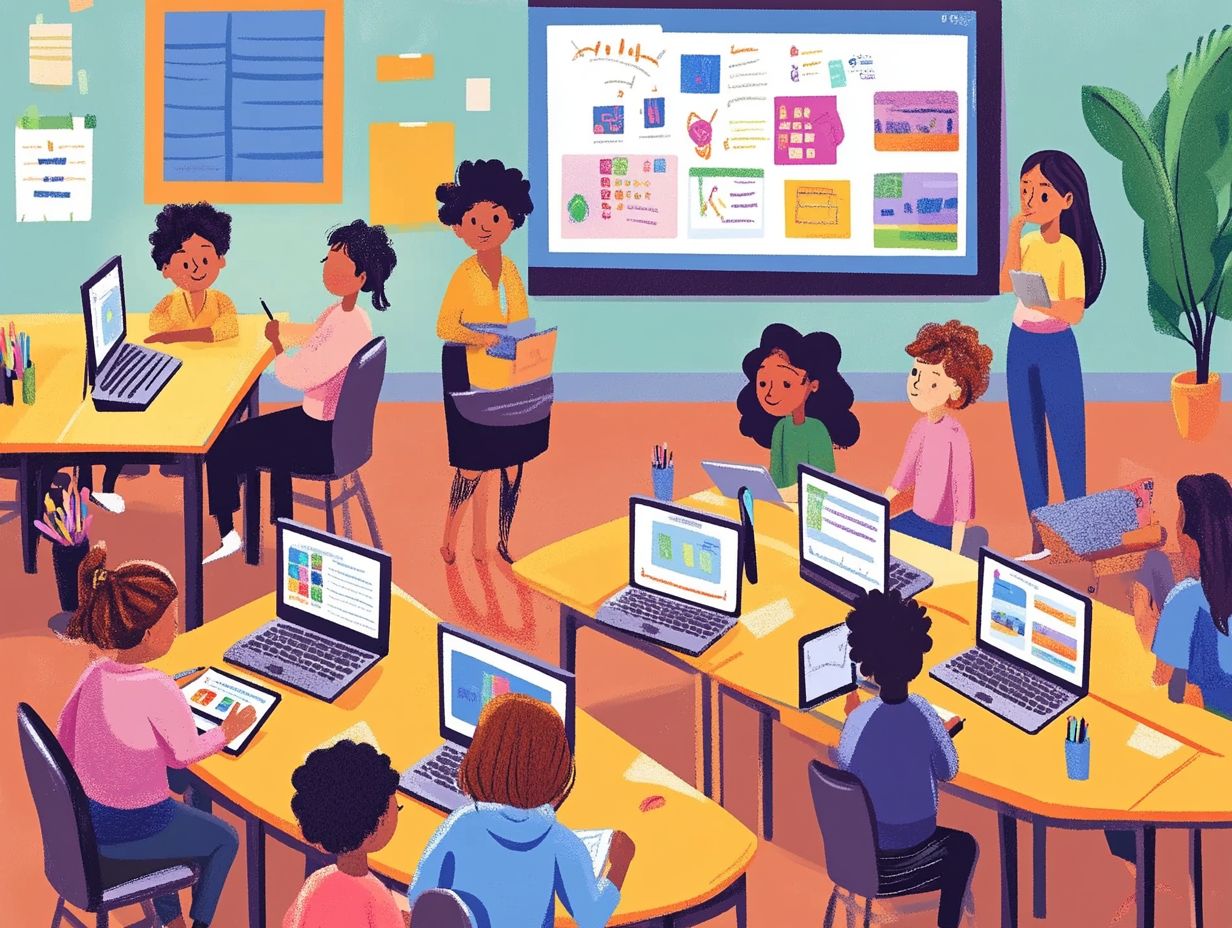5 Examples of Successful E-Learning Implementation
In today’s fast-paced world, e-learning has revolutionized how we acquire knowledge and skills.
From Khan Academy’s innovative approach to education to Duolingo’s engaging language lessons, the online learning landscape is flourishing.
This piece explores five standout platforms Khan Academy, Duolingo, Coursera, Codecademy, and Udemy that are changing how individuals and organizations learn.
It also examines the benefits, challenges, and potential future of e-learning. You’ll gain insights on how to effectively maximize these opportunities.
Get ready to dive into the exciting world of e-learning! Join the movement that’s reshaping education.
Don’t miss out on the chance to transform your learning experience today!
Contents
- Key Takeaways:
- 1. Khan Academy: Revolutionizing Education
- 2. Duolingo: Making Language Learning Fun and Accessible
- 3. Coursera: Bringing Higher Education to the Masses
- 4. Codecademy: Empowering Individuals to Learn Coding
- 5. Udemy: A Platform for Diverse Learning Opportunities
- How Can E-Learning Benefit Individuals and Organizations?
- Frequently Asked Questions
- What are some examples of successful e-learning implementation?
- How have these examples of successful e-learning implementation impacted learners?
- What are some key factors that contribute to the success of e-learning implementation?
- Can e-learning be effective for all types of learners?
- What are some challenges that may arise during the implementation of e-learning?
- What can organizations do to ensure the success of e-learning implementation?
Key Takeaways:

- Effective e-learning has the power to make education more accessible, as seen in the success of platforms like Khan Academy and Coursera.
- Innovative approaches, such as gamification in Duolingo and hands-on learning in Codecademy, make e-learning engaging for individuals of all backgrounds.
- E-learning can benefit both individuals and organizations through increased flexibility and access to diverse learning opportunities on platforms like Udemy.
1. Khan Academy: Revolutionizing Education
Khan Academy is a transformative force in e-learning. It uses new technology to provide accessible educational resources for learners worldwide.
By integrating interactive exercises, instructional videos, and personalized learning dashboards, this platform caters to various learning styles. It democratizes access to high-quality education.
You have the freedom to engage with material at your own pace, creating a tailored educational experience. This accessibility significantly impacts underserved communities, breaking down financial barriers to education.
Khan Academy plays a crucial role in transforming traditional learning environments. It fosters self-directed learning and equips you with the skills needed for success in the modern workforce.
2. Duolingo: Making Language Learning Fun and Accessible
Duolingo has transformed language learning into an engaging experience. It utilizes gamification elements that inspire you to continue your studies in a fun way.
This innovative approach integrates point scoring, reward badges, and daily streaks to encourage consistency. The platform s progress tracking system allows you to visualize your advancements, fostering a sense of achievement.
The community aspect is equally vital; here, you can connect with fellow learners, exchange tips, and engage in friendly competition. These elements create a dynamic learning environment, keeping you committed to reaching your language goals while developing practical skills.
3. Coursera: Bringing Higher Education to the Masses
Coursera has transformed access to higher education, collaborating with esteemed institutions like MIT and Harvard to provide a variety of online courses and professional certificates.
These offerings include Massive Open Online Courses (MOOCs), allowing you to engage in flexible learning at your own pace. This flexibility fits various schedules and learning preferences.
Coursera enables professionals to elevate their skills in a fast-changing job market, providing knowledge in vital fields such as data science, business, and computer programming.
Through these innovative learning pathways, you can bridge essential knowledge gaps, enhancing your career prospects and embracing lifelong learning. Coursera supports workforce development and adapts to an ever-evolving economy.
4. Codecademy: Empowering Individuals to Learn Coding

Codecademy enables you to master coding skills through interactive classes. These classes teach programming languages like Python and prepare you for the job market. They emphasize real-world applications and project-based learning.
This approach allows you to engage directly with the material. It fosters a deeper understanding of coding concepts. For instance, courses like “Learn JavaScript” and “Data Science Career Path” provide theoretical knowledge. They also challenge you to complete projects that mimic industry scenarios.
By tackling these hands-on assignments, you can build a portfolio that showcases your abilities. This significantly enhances your employability.
Codecademy updates its curriculum to align with the evolving demands of tech companies. This ensures you acquire the most relevant skills, such as responsive web design and data analysis. These skills are highly sought after in today s job market.
5. Udemy: A Platform for Diverse Learning Opportunities
Udemy presents you with a vast marketplace for online learning. It offers an impressive array of courses that cater to everything from professional development to personal hobbies.
The platform fosters a community atmosphere that encourages collaboration between learners and instructors. This makes the experience even richer.
With thousands of options available, you can explore various subjects at your own pace. This flexibility allows you to customize your educational journey to suit your unique needs and busy schedule. It is especially beneficial if you re juggling work, family, or other commitments.
The platform s interactive features, like forums and Q&A sections, enable you to connect with instructors and fellow students. This exchange of insights enhances your understanding and creates a supportive environment that inspires you to pursue your goals effectively.
How Can E-Learning Benefit Individuals and Organizations?
E-learning can transform your learning experience! It offers a wealth of benefits for you, whether you re an individual or part of an organization.
It enhances skill development, increases accessibility, and provides affordability. This effectively addresses knowledge gaps while fostering a culture of continuous learning in today s fast-paced job market.
As an individual, imagine the unparalleled flexibility e-learning brings. You can learn at your own pace and on your own schedule. This is particularly advantageous for those balancing work, family, and academic commitments. You can create a personalized learning experience that aligns with your unique learning style.
On the organizational side, companies like AT&T and Deloitte have integrated e-learning platforms seamlessly. This approach cuts training costs while boosting employee engagement, much like the 5 popular e-learning tools for corporations.
By offering interactive modules and on-demand resources, these organizations enhance retention rates. They also help employees feel more invested in their skill development and career growth.
What Are the Key Factors for Successful E-Learning Implementation?
Successful e-learning implementation hinges on several key factors. These include effective learning management systems, thorough instructor training, and strong assessment strategies. Exploring innovative e-learning case studies can demonstrate how these elements work together to create an engaging and impactful learning experience.
These elements form a cohesive framework that promotes learner engagement and knowledge retention. A well-designed learning management system streamlines course delivery and provides analytics to track progress.
Comprehensive instructor training equips you with modern pedagogical techniques. This enables you to facilitate discussions and cultivate a collaborative online atmosphere. Robust assessments offer crucial feedback, helping learners identify their strengths and areas for growth.
Embracing organizational change is equally important. It fosters a culture that values ongoing learning and adaptability. This reinforces the significance of feedback in refining the learning process and the overall educational environment.
What Are the Challenges of Implementing E-Learning?

E-learning offers many advantages but also presents challenges. These include technology barriers, knowledge gaps, and the struggle to keep learners engaged, which can be addressed by understanding the learning theories behind e-learning success.
Unequal access to reliable internet and devices can disadvantage some students. The lack of face-to-face interaction may reduce motivation and create feelings of isolation.
Consider blended learning approaches to tackle these challenges. By combining traditional methods with digital ones, you can enhance engagement.
Providing personalized feedback and using interactive platforms can transform learning. Make it relevant and engaging for every learner!
How Can Organizations Overcome Resistance to E-Learning?
To overcome resistance to e-learning, use a strategic approach. Focus on effective training, actionable feedback, and a culture of collaboration, as highlighted in e-learning success stories from top corporations.
Involve employees in the design process. Their insights can enhance engagement and support for e-learning.
Clearly communicate the benefits of e-learning, such as efficiency and flexibility. This can alleviate concerns and highlight its value.
Regular updates and open communication build trust. Support systems, like mentoring and resources, help ease transitions.
What Are the Future Possibilities for E-Learning?
The future of e-learning is set for amazing advancements! Digital transformation, cloud technologies, gamification, and 5 strategies for effective e-learning content will enrich learning experiences.
This evolving landscape allows you to create dynamic learning environments. Interactive workshops will provide hands-on experiences to promote collaboration.
Gamification will make learning enjoyable, motivating you with rewards and challenges. It’s all about making education fun!
This approach fosters deeper engagement and skill development. Personalized learning journeys are becoming a reality, changing how you acquire knowledge!
How Can Individuals Make the Most of E-Learning Opportunities?
Maximizing the benefits of e-learning requires active engagement in your learning journey. Set clear goals and use available resources like assessments and feedback mechanisms to improve your educational outcomes.
To enhance your learning experience, break larger objectives into actionable steps. This creates a roadmap to success that boosts your motivation and helps maintain focus. You can monitor your progress with precision.
Developing self-discipline, or the ability to stay focused on your study plan, is vital. A consistent study schedule can make a significant difference. By using digital tools for self-assessment and seeking constructive feedback, you’ll gain insights into your strengths and areas for improvement, leading to a richer e-learning experience.
Frequently Asked Questions

What are some examples of successful e-learning implementation?
- The Khan Academy: This non-profit organization provides free online educational videos and resources for learners of all ages. It has helped millions of students worldwide to improve their understanding of various subjects.
- Duolingo: This language-learning platform is popular for its user-friendly interface and interactive lessons. It makes language learning more accessible and engaging.
- Coursera: Offers courses from top universities and organizations, making quality education accessible to a wider audience through interactive features.
- Codecademy: Dive into coding with this fun platform that uses interactive projects and real-time feedback to make learning enjoyable.
- LinkedIn Learning: Provides a wide range of courses for professionals looking to enhance their skills. Its integration with LinkedIn helps users showcase their new skills to potential employers.
How have these examples of successful e-learning implementation impacted learners?
These platforms have greatly impacted learners by providing access to quality education and professional development opportunities. Additionally, 5 ways to encourage knowledge sharing via e-learning have made learning more convenient and engaging, leading to higher retention rates and better knowledge retention.
What are some key factors that contribute to the success of e-learning implementation?
Key factors for successful e-learning include:
- User-friendly interfaces
- Interactive and engaging content
- Personalized learning experiences
- Accessibility across devices
- Effective use of technology
- Regular updates and continuous evaluation
Can e-learning be effective for all types of learners?
E-learning is effective for many learners, but it may not suit everyone. Some might prefer traditional classroom settings or hands-on experiences. However, with advancements in technology and diverse learning styles, 5 ways to enhance accessibility in e-learning are evolving to meet various needs.
What are some challenges that may arise during the implementation of e-learning?
Common challenges during e-learning implementation include:
- Technical issues
- Lack of proper training for instructors
- Resistance to change from traditional methods
- Ensuring equal access to technology and resources
What can organizations do to ensure the success of e-learning implementation?
To ensure successful e-learning implementation, organizations must invest in user-friendly and interactive platforms, focusing on the key elements of effective e-learning.
They must provide proper training for instructors and offer ongoing support.
Organizations should check regularly to identify areas for improvement.
Equal access to technology and resources is crucial for all learners.
Finally, organizations must adapt to the changing needs and preferences of their learners.






